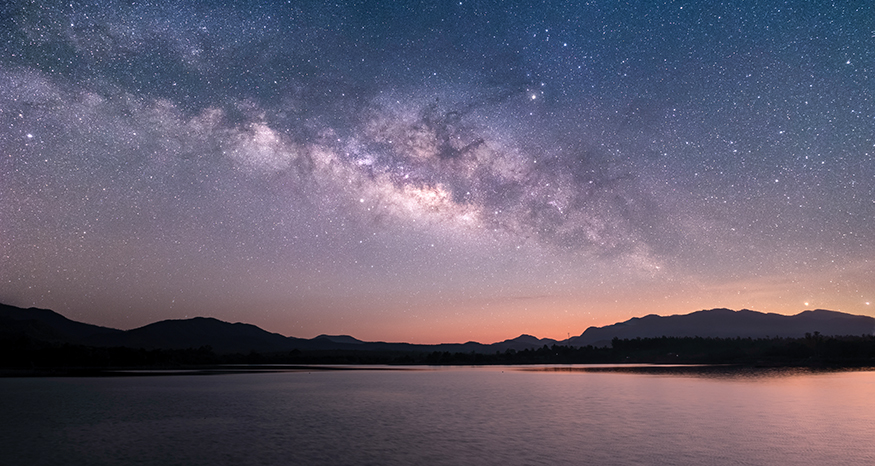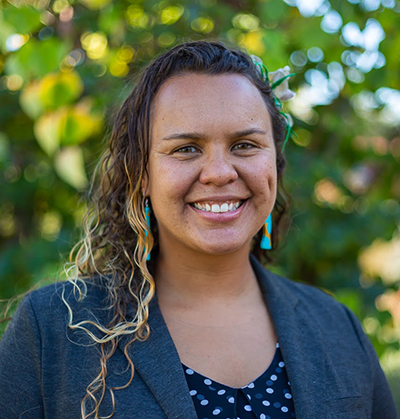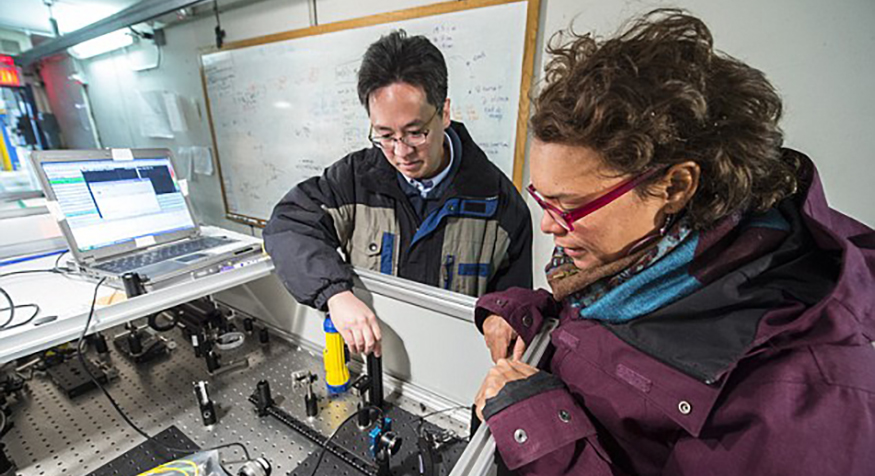
Gaze up at the sky on a clear night. What do you see? A stunning display of our moon, planets, stars, and galaxies? Clues to understanding the entire universe? A celestial map for navigating around the planet?
For Brittany Kamai, visiting professor in the Department of Astronomy in the UW College of Arts & Sciences, the answer is all three.
Kamai is an astrophysicist with knowledge of Pacific Islanders’ Indigenous navigation — the use of the stars, winds, and waves as a guide for navigating across the Pacific Ocean. This spring quarter, she is combining her scientific and Indigenous knowledge in a new UW astronomy course: Pacific Indigenous Astrophysics. The course is being offered through a Native Knowledge Lecturer Grant from the UW’s Center for American Indian and Indigenous Studies (CAIIS).
“What’s beautiful about this grant is that it has given me the freedom to create a course that has never been taught before, by combining my academic path in astrophysics with my ancestral knowledge as a Native Hawaiian and a Pacific Islander,” she says. “It is very exciting.”
Driven by Curiosity
Growing up in urban Honolulu, Kamai never felt a strong connection to the night sky. That changed when she took an introductory astronomy course in college. What really hooked her was learning that the vast majority of the universe is made up of dark energy and dark matter, which still remain a mystery to astronomers.

“At the end of the course, I went to my teacher and asked, ‘How do I figure out what dark energy is?’” Kamai recalls. “The teacher told me to start by majoring in physics. I went back home and told everyone I was going to major in physics, and they all thought I was in over my head — including my high school teachers.”
Kamai proved them wrong. She earned a BS, MA, MS, and PhD in physics, and then continued to work on the Nobel-prize winning gravitational-wave project, LIGO, before stepping into a leadership role on Cosmic Explorer, an instrument being developed to deepen and clarify humanity’s gravitational-wave view of the cosmos.
Along the way, Kamai co-founded the Society of Indigenous Physicists (SIP), a forum to connect with other Indigenous scientists. “So many of us are the only Indigenous people in anything that we’ve done in physics,” she says. “Many of us are the first and only from our nations. This is a chance for us to be together and have high-level conversations about our respective fields but also incorporate discussions about our ancestral and spiritual knowledge that connects with our work.” Encouragement and letters of support from SIP colleagues led to Kamai's current course at the UW.
Trained in Two Worlds
Kamai designed her Pacific Indigenous Astrophysics course to be accessible to all UW students. No astronomy or physics background is required. “I plan to talk about black holes and the entire universe from a Western lens, but also teach the students to see the way we connect with the stars in the Pacific,” Kamai says.
Kamai is uniquely suited to teach such a class. In addition to her expertise as an astrophysicist, she has spent the past few years training in the ancestral practice of voyaging. She has traveled as crew in traditional canoes — such as Hōkūleʻa and Moʻokiha ʻo Piʻilani — and learned how Pacific Islanders from Hawaiʻi, Satawal, and Lamotrek use the sky to navigate across vast expanses of ocean. Kamai also is part of the Kānehūnāmoku Voyaging Academy, which visits public schools and local communities in Hawai’i to pass on this Indigenous knowledge.

While Pacific Indigenous navigation is often described as navigation without instruments, Kamai says a more accurate description would be navigation that uses no external instruments. “You are the instrument,” she explains, referring to the navigator. “You are the sensor. You become so tuned into the sights, smells, sounds, and feelings around you that you can take that information and make decisions, turning left and right at stars and sea markers.”
Kamai offers the example of the night sky as a marker for latitude. With a change in latitude as you head south, the North Star will descend and the Southern Cross will ascend. Those who know the stars can identify their latitude even if they are far from home. When stars are not visible, the sun and moon and planets provide information, as do the wind and the waves. Learning how to interpret these clues takes time and training.
“I have a PhD in astrophysics, but that didnʻt teach me how to get between Hawaiʻi and Tahiti using the stars,” Kamai says. “It’s a totally different knowledge system.”
Become Friends with the Sky
Despite the very different ways that Western scientists and Indigenous navigators approach the night sky, Kamai finds commonalities.
“In the scientific method, you make hypotheses, collect data, make assessments, and come back and ask more questions,” she says. “Training as a navigator is the same. All of it is based on observation. In both the scientific method and Indigenous practices, you go out and observe and observe and observe and try to figure out what the Earth is telling you. Both worlds are doing the same thing.”

The biggest difference, Kamai says, is that Indigenous practices emphasize cultural traditions and one’s relationship to place. Western science treats the astronomer’s cultural identity as separate from their research, yet that personal connection with the sky is integral in Indigenous astronomy.
I have a PhD in astrophysics, but that didn't teach me how to get between Hawaiʻi and Tahiti using the stars. It’s a totally different knowledge system.
Kamai introduces this distinction at the start of the course, asking students if they know the Western names of the stars they see in Seattle and if those stars have different names in other languages they might speak. She shares how every culture has its own names and stories about the celestial world, and how those stories build our relationship with the night sky. She is particularly excited to share this perspective with physics and astronomy majors whose discipline focuses on data more than physical connection with the sky.
“For students who have chosen this field, my message is to be friends with the sky,” she says. “Start to see and honor different cultural stories that go along with it.”
And for everyone else?
“I hope the students become more connected to their place everywhere they go,” she says. “They will have this toolkit of how to get oriented, how to connect with a place through the stars. I’d also like them to leave the class as advocates for Indigenous communities because they’ve seen the brilliance of our practices.”
More Stories

Exploring Connections Through Global Literary Studies
The UW's new Global Literary Studies major encourages students to explore literary traditions from around the globe and all eras of human history.

The Truth About Public Speaking
Becoming an effective public speaker requires planning and practice. Professor Matt McGarrity and consultants at the UW Center for Speech & Debate are available to help.

A Closer Look at Teens & Digital Technology
The impact of digital technology on teens' mental health is the focus of a new course developed by Lucia Magis-Weinberg in the UW Department of Psychology.
